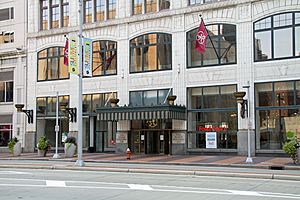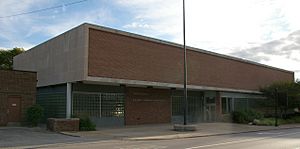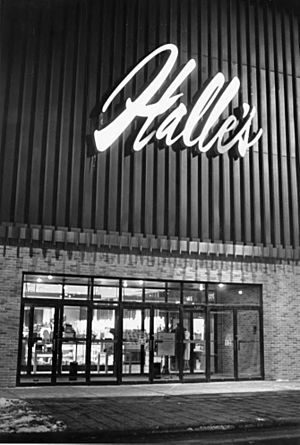Halle Brothers Co. facts for kids

The Halle Building
|
|
| Industry | Retail |
|---|---|
| Fate | Liquidation |
| Founded | 1891 |
| Founders | Samuel Horatio Halle Salmon Portland Chase Halle |
| Defunct | 1982 |
| Headquarters | , |
| Products | Clothing, footwear, bedding, furniture, jewelry, beauty products, and housewares. |
Halle Brothers Co., often called Halle's, was a famous department store chain. It was located in Cleveland, Ohio. For most of its 91 years, Halle's sold fancy items. They also offered great personal service. It was the first big department store in Cleveland to open a branch outside the city center.
Contents
The Story of Halle's Department Store
Halle Brothers Co. was a top department store in Cleveland, Ohio. Two brothers, Samuel Horatio Halle and Salmon Portland Chase Halle, started it. They opened their first store on February 7, 1891.
Their very first shop was at 221 Superior Avenue. It was near the city's Public Square. The brothers bought a hat and fur shop there. In 1902, their business officially became "The Halle Bros. Co." Later, they moved to Euclid Avenue. They also started selling ready-to-wear clothes.
How Halle's Grew
Halle's moved and grew several times. By 1910, they built their main store. It was at 1228 Euclid Avenue. This building was 195 feet tall. It was the tallest department store ever built in Cleveland.
A New York architect named Henry Bacon designed it. People said it looked elegant and refined. Its outside was made of white terra cotta. In 1927, they opened a new building. It cost $5 million. This created a huge shopping area. It is now part of Cleveland's Theater District.
Halle's was known as a high-end store. They were praised for opening stores outside the main downtown area. By 1927, Halle's sold items in parts of New York, Pennsylvania, Northeast Ohio, and Indiana.
Halle's was famous for its personal service. Every new employee learned about their promise to customers. The company wanted staff to be honest and fair. They believed in doing what was right.
When the main store grew in 1927, TIME magazine praised it. They said Halle's helped Cleveland become a more modern city. They compared Halle's to other famous stores.
Halle's faced problems during the Great Depression. But business got better after World War II. In 1948, Walter Murphy Halle led the company. They started opening stores in the suburbs. They also spent $10 million to update the main store. This included a new service building. They also added a West Wing in 1949.
The store became very popular. This was especially true during Christmas. The main store had its own Santa Claus. He was a fictional elf named Mr. Jingeling. Kids knew him as Santa's "Keeper Of The Keys." A TV and radio jingle said he was "on Halle's seventh floor." Mr. Jingeling started in 1956. He helped promote the store's toys. He was so popular that he became an annual tradition.
In 2014, the K & D Group bought the Halle Building. They planned to turn it into fancy apartments. The building was sold for $20 million. It was then made into luxury apartments.

Halle's Faces Challenges
Halle's lasted longer than many other stores in Cleveland. But the 1960s brought tough times. Other big stores downtown closed. The Playhouse Square theaters also declined. Shopping moved to Cleveland's Public Square. Rivals like Higbee's and The May Company had stores there. They were easy to reach by Rapid Transit.
Halle's tried to help customers. In 1956, they leased buses. These buses offered free rides from Public Square to Playhouse Square. This was meant to be a short-term fix. They hoped a subway would be built under Euclid Avenue. But the subway project never happened. So, Halle's had to keep the shuttle service.
Without other stores nearby, fewer people came downtown. Crime also increased in the area. It became harder for suburban shoppers to visit the main Halle's store. In 1969, Halle's changed its charge cards. They issued their own pink cards. This was like what other stores were doing.
The main store was too big. Downtown Cleveland was losing shoppers. Halle's had also expanded too much into other areas. In 1970, Marshall Field's bought the company. Under their ownership, Halle's struggled. It fell behind local rivals. These included Higbee's and May Company.
Halle's tried to sell cheaper goods. This was to attract more customers. But it did not work. In 1974, Chisholm Halle resigned. He was the grandson of the founder. In 1969, Halle's changed its old fancy logo. They used a simpler, modern look. They also shortened their name to "Halle's." But customers did not like this new logo. So, in late 1969, Halle's brought back its old logo. After Marshall Field's bought the chain, they tried to modernize Halle's again in 1971. They changed the logo to match Marshall Field's.
The End of Halle's
In November 1981, Field's sold Halle's. By then, Halle's had 15 stores. They were in Ohio and Pennsylvania. Associated Investors Corporation bought them. This company was led by Columbus, Ohio businessman Jerome Schottenstein. He also owned Value City discount stores.
At first, the sale seemed promising. Schottenstein promised to keep Halle's traditions alive. He even placed full-page newspaper ads. But in 1982, Associated Investors closed the company. All the stores were either sold or shut down. They tried to keep a smaller group of six suburban stores open. But it did not work.
Halle's had planned a store at Randall Park Mall in the 1970s. But they canceled the idea. The space remained empty. Later, a movie theater was built there in the late 1990s.
Columbus Stores
The Union Co. was an upscale department store. It had six locations around Columbus, Ohio. In 1980, Marshall Field & Co. bought The Union Co. for $8 million. They then changed the name of these stores to Halle's.



